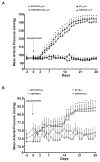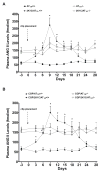Pivotal role of angiotensin II receptor subtype 1A in the development of two-kidney, one-clip hypertension: study in angiotensin II receptor subtype 1A knockout mice
- PMID: 18551014
- PMCID: PMC2704388
- DOI: 10.1097/HJH.0b013e3282fe6eaa
Pivotal role of angiotensin II receptor subtype 1A in the development of two-kidney, one-clip hypertension: study in angiotensin II receptor subtype 1A knockout mice
Abstract
Objective: The present study was performed to examine in two-kidney, one-clip (2K1C) Goldblatt hypertensive mice: first, the relative contribution of angiotensin II receptor subtypes 1A (AT(1A)) and 1B (AT(1B)); second, the role of angiotensin II type 2 (AT(2)) receptors in the development of hypertension in wild-type (AT(1A)+/+) and AT(1A) receptor knockout (AT(1A)-/-) mice; and third, the role of increased nitric oxide synthase activity in counteracting the hypertensinogenic action of angiotensin II in this model.
Methods: AT(1A)+/+ and AT(1A)-/- mice underwent clipping of one renal artery and were infused with either saline vehicle or selective AT(2) receptor agonist CGP-42112A (CGP). Blood pressure was monitored by radiotelemetry. Blood pressure responses to the nitric oxide synthase inhibitor nitro-L-arginine-methyl-ester were evaluated.
Results: AT(1A)+/+ mice responded to clipping by a rise in blood pressure that was not modified by CGP infusion. Clip placement caused a slight increase in blood pressure in AT(1A)-/- mice that remained significantly lower than in AT(1A)+/+ mice. Acute nitric oxide synthase inhibition caused greater increase in blood pressure in 2K1C/AT(1A)+/+ than in AT(1A)+/+ mice.
Conclusion: The present data support the critical role of AT(1A) receptors in the development of 2K1C hypertension, whereas AT(1B) receptors play only a minor role in blood pressure regulation in this model of angiotensin II-dependent hypertension. Activation of AT(2) receptors does not play an antagonistic role in the AT(1) receptor-mediated hypertensinogenic actions of angiotensin II in this model. Finally, enhanced nitric oxide synthase activity plays a protective role by counteracting the vasoconstrictor influences of angiotensin II in 2K1C hypertensive mice.
Conflict of interest statement
Figures




Similar articles
-
Essential role of AT1A receptor in the development of 2K1C hypertension.Hypertension. 2002 Nov;40(5):735-41. doi: 10.1161/01.hyp.0000036452.28493.74. Hypertension. 2002. PMID: 12411470
-
Renovascular hypertension in mice with brain-selective overexpression of AT1a receptors is buffered by increased nitric oxide production in the periphery.Circ Res. 2004 Sep 3;95(5):523-31. doi: 10.1161/01.RES.0000140892.86313.c2. Epub 2004 Jul 29. Circ Res. 2004. PMID: 15284190
-
Knockout of angiotensin 1-7 receptor Mas worsens the course of two-kidney, one-clip Goldblatt hypertension: roles of nitric oxide deficiency and enhanced vascular responsiveness to angiotensin II.Kidney Blood Press Res. 2010;33(6):476-88. doi: 10.1159/000320689. Epub 2010 Nov 10. Kidney Blood Press Res. 2010. PMID: 21071955
-
[Angiotensin type 2 receptor-dependent vasodilation].Yakugaku Zasshi. 2007 Sep;127(9):1357-67. doi: 10.1248/yakushi.127.1357. Yakugaku Zasshi. 2007. PMID: 17827918 Review. Japanese.
-
Angiotensin receptors in the kidney and vasculature in hypertension and kidney disease.Mol Cell Endocrinol. 2021 Jun 1;529:111259. doi: 10.1016/j.mce.2021.111259. Epub 2021 Mar 27. Mol Cell Endocrinol. 2021. PMID: 33781840 Review.
Cited by
-
Effects of Renal Denervation on the Enhanced Renal Vascular Responsiveness to Angiotensin II in High-Output Heart Failure: Angiotensin II Receptor Binding Assessment and Functional Studies in Ren-2 Transgenic Hypertensive Rats.Biomedicines. 2021 Nov 30;9(12):1803. doi: 10.3390/biomedicines9121803. Biomedicines. 2021. PMID: 34944619 Free PMC article.
-
High-salt intake enhances superoxide activity in eNOS knockout mice leading to the development of salt sensitivity.Am J Physiol Renal Physiol. 2010 Sep;299(3):F656-63. doi: 10.1152/ajprenal.00047.2010. Epub 2010 Jul 7. Am J Physiol Renal Physiol. 2010. PMID: 20610532 Free PMC article.
-
Downregulation of the ACE2/Ang-(1-7)/Mas axis in transgenic mice overexpressing GH.J Endocrinol. 2014 Apr 22;221(2):215-27. doi: 10.1530/JOE-13-0497. Print 2014 May. J Endocrinol. 2014. PMID: 24756097 Free PMC article.
-
Effects of salt loading on sympathetic activity and blood pressure in anesthetized two-kidney, one clip hypertensive rats.Bosn J Basic Med Sci. 2011 Nov;11(4):228-33. doi: 10.17305/bjbms.2011.2555. Bosn J Basic Med Sci. 2011. PMID: 22117829 Free PMC article.
-
Renin, endothelial NO synthase and endothelin gene expression in the 2kidney-1clip Goldblatt model of long-term renovascular hypertension.Eur J Med Res. 2009;14(12):520-5. doi: 10.1186/2047-783x-14-12-520. Eur J Med Res. 2009. PMID: 20149985 Free PMC article.
References
-
- Navar LG, Zou L, Von Thun A, Wang CT, Imig JD, Mitchell KD. Unraveling the mystery of Goldblatt hypertension. News Physiol Sci. 1998;13:170–176. - PubMed
-
- Cervenka L, Wang CT, Mitchell KD, Navar LG. Proximal tubular angiotensin II levels and renal functional responses to AT1 receptor blockade in nonclipped kidneys of Goldblatt hypertensive rats. Hypertension. 1999;33:102–107. - PubMed
-
- Kobori H, Nangaku M, Navar LG, Nishiyama A. The intrarenal renin-angiotensin system: from physiology to the pathobiology of hypertension and kidney disease. Pharmacol Rev. 2007;59:251–287. - PubMed
-
- Ingert C, Grima M, Coquard C, Barthelmers M, Imbs JL. Contribution of angiotensin II internalization to intrarenal angiotensin II levels in rats. Am J Physiol. 2002;283:F1003–F1010. - PubMed
-
- Navar LG, Nishiyama A. Why are angiotensin concentrations so high in the kidney? Curr Opin Nephrol Hypertens. 2004;13:107–115. - PubMed
Publication types
MeSH terms
Substances
Grants and funding
LinkOut - more resources
Full Text Sources
Medical
Molecular Biology Databases
Research Materials

